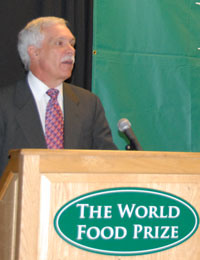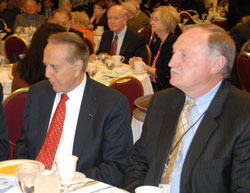 The state of Oklahoma is set to host its third annual biofuels conference.
The state of Oklahoma is set to host its third annual biofuels conference.
Governor Brad Henry will host GROW: The Oklahoma Biofuels Conference, November 12-13 in Oklahoma City at the Skirvin Hotel conference center. The conference is touted as a chance to appeal to a broad range of attendees including: biofuel producers, marketers and retailers; end users, including public and private fleet managers; research institutions; farmers, ranchers and agribusiness executives; private equity firms, venture capitalists, lenders and financial institutions; government regulators and representatives; entrepreneurs and anyone with an interest in this new and rapidly expanding Oklahoma energy industry:
The 2008 Oklahoma Biofuels Conference will cover topics that include:
• New and proposed initiatives and funding for bioenergy research including
the 2008 Farm Bill
• 2nd generation feedstocks for Oklahoma
• Discussion on food v. fuel debate
• Biorefinery construction – new players, plans and progress
• Biofuel impacts for end users
• Carbon control policies that may offer income potential for producers
• Energy sustainability
• Advances in feedstock conversion technology
For registration and more information, check out the conference web site, www.growok.com, or you can call 1-800-203-5494.


 Export opportunities for the livestock feed co-product of ethanol production are increasing as the industry continues to grow. That was the main message to more than 500 who attended the second the
Export opportunities for the livestock feed co-product of ethanol production are increasing as the industry continues to grow. That was the main message to more than 500 who attended the second the  “The reason we’re holding this conference is that we are confident the U.S. ethanol industry will continue to grow due to efforts undertaken by the National Corn Growers Association and state producer organizations over the last several years,” said USGC president and CEO Ken Hobbie. “Due to the efforts of U.S. growers to establish the ethanol industry, we made DDGS our top priority in 2006 and since then have seen DDGS exports exceed 2 million metric tons annually.”
“The reason we’re holding this conference is that we are confident the U.S. ethanol industry will continue to grow due to efforts undertaken by the National Corn Growers Association and state producer organizations over the last several years,” said USGC president and CEO Ken Hobbie. “Due to the efforts of U.S. growers to establish the ethanol industry, we made DDGS our top priority in 2006 and since then have seen DDGS exports exceed 2 million metric tons annually.”  The South Carolina Bioenergy Research Collaborative has been formed to demonstrate the economic feasibility of using plants, such as switchgrass, trees and sorghum, to make ethanol. The collaborative includes scientists at Clemson, the Savannah River National Laboratory, South Carolina State University and industry incubator SC Bio, as well as industrial partners who are committed to building a pilot plant in the state.
The South Carolina Bioenergy Research Collaborative has been formed to demonstrate the economic feasibility of using plants, such as switchgrass, trees and sorghum, to make ethanol. The collaborative includes scientists at Clemson, the Savannah River National Laboratory, South Carolina State University and industry incubator SC Bio, as well as industrial partners who are committed to building a pilot plant in the state.

 Ethanol plants that have been hurt by dramatic fluctuations in commodity prices this year could be eligible for assistance from the US Department of Agriculture.
Ethanol plants that have been hurt by dramatic fluctuations in commodity prices this year could be eligible for assistance from the US Department of Agriculture. USB was one of the soybean industry sponsors of the
USB was one of the soybean industry sponsors of the  Voters in California are being asked to approve a $5 billion bond measure that is designed to help spur the growth of alternative fuels in the state.
Voters in California are being asked to approve a $5 billion bond measure that is designed to help spur the growth of alternative fuels in the state. Kinder Morgan Energy Partners LP has announced successful testing of ethanol through its 16-inch, 195-mile Central Florida Pipeline (CFP) system between Tampa and Orlando, Florida and the beginning of testing of a biodiesel pipeline in the Southeast U.S.
Kinder Morgan Energy Partners LP has announced successful testing of ethanol through its 16-inch, 195-mile Central Florida Pipeline (CFP) system between Tampa and Orlando, Florida and the beginning of testing of a biodiesel pipeline in the Southeast U.S.